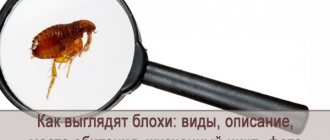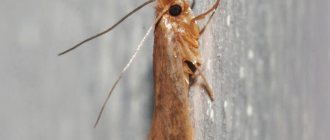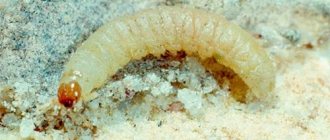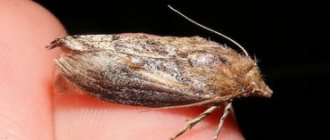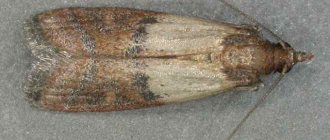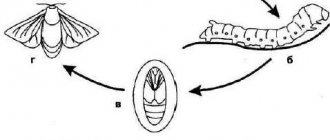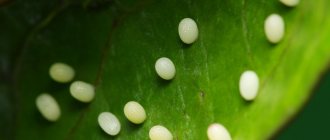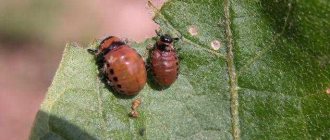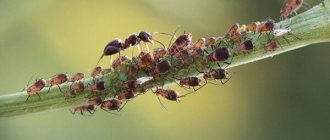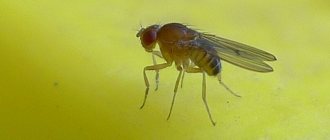Moths are a pest that enters the house and causes a lot of trouble for the owners. Not only clothes made of wool or fur suffer from voracious insects; depending on the type of pest, food and even furniture can be at risk.
To successfully fight moths, you need to know about the stages of insect development, since the main danger is not the adults, but the larvae.
Description and characteristics of the insect
Moths are lepidopteran insects. There are more than 2,000 species in the world, representatives of which are characterized by small size, narrow wings, and nondescript camouflage coloring.
Almost all types of moths begin to become active at dusk. Adults do not eat, but subsist on nutrients that were accumulated during the caterpillar stage. But the larvae are very voracious. They cause the main damage to plants, products or tissues (depending on the type of moth).
Appearance of a moth
Despite the diversity of species, outwardly all members of the family are similar to each other. An adult food or clothes moth looks like a moth ranging in size from 0.5 to 1.3 cm. The color varies from gray to brown, the wings have a slight pearlescent tint.
If you look closely, you can distinguish food moths from clothes moths both by size and color. The dress one is slightly larger, and the color is closer to golden brown. The food is smaller, and the shade of the wings is darker, brownish-gray.
Varieties
Lifespan
How long a moth lives depends on environmental conditions and the type of pest. On average, the lifespan of an adult is from 1 to 4 weeks. The larval stage, during which insects actively feed and cause the main damage during their life, lasts from 1 to 4 months.
Mole: photo
If you find it difficult to determine the type of pest, look at how each moth looks in the photo and compare it with the parasites that you have.
Clothes moth
- The color of the moth is from light beige to pale yellow, the hind wings are several tones lighter than the front wings, and can be slightly transparent.
- The tips of the fore wings and the lower edge of the hind wings are covered with feathery hairs.
- The wingspan of the butterfly reaches 1–2 centimeters.
- The head has long whiskers that can twist and bend at unnatural angles, as if they had been singed.
- The insect has an oblong body up to 1 centimeter long, the same color as the wings.
food moth
- The color of the front wings of the food moth is marbled, speckled, in brown and beige tones.
- The hind wings are plain, light beige, covered with long hairs resembling a fluffy fringe.
- The wingspan of the butterfly reaches 1–2 centimeters.
- On the head there are 2 straight, thin whiskers diverging to the sides, like antennas.
- The body is elongated, covered with hairs, up to 1 centimeter in length.
If you have seen a clothes or food moth at the butterfly stage in your home, it means it has already laid its larvae somewhere.
Types of house pests
The definition of “domestic” refers to all types of moths living in an apartment or house. There are several main types of house moths:
- food (lives mainly in the kitchen, eats cereals, cereals, nuts, dried fruits);
- clothes (lives in closets with clothes, feeds on fabrics);
- fur coat (eats fur);
- furniture (settles on upholstered furniture, feeds on its upholstery);
- carpet (lays eggs and develops in the pile of various carpets).
The differences between species are not only in what the moth looks like, but also in where it lives and what it eats. Thus, clothes moth larvae will never end up in a package of cereal, and food moths will not spoil a fur coat or woolen sweater.
Where do moths come from in an apartment?
These insects appear in homes in different ways. The method of their appearance depends on whether they infect food or clothing.
food moth
Insect larvae can feed on a variety of foods, including:
- flour;
- grains (oats, barley, wheat);
- oat and corn flakes;
- bakery products;
- pasta;
- sugar;
- seeds;
- nuts;
- cereals (buckwheat, corn, semolina, rice);
- dried fruits, etc.
It is believed that different types of moths are able to absorb only one particular food. In practice, any insect eats any food. Food black moths are not capable of ruining clothes. This is due to the fact that its digestive juices contain enzymes that cannot digest tissue fibers.
Clothes parasites
Moth larvae and eggs can get into your closet even with new clothes purchased from large stores. The sources of damage are woolen products and upholstered furniture, the upholstery of which is made of natural materials. The risk of moths entering the closet increases if worn items are purchased. The insect destroys the following clothing:
- knitwear;
- fur-lined shoes;
- cashmere, leather and cotton clothes;
- furniture upholstery;
- woolen products;
- sheepskin coats and fur coats based on natural fur;
- carpets;
- felt boots;
- bedding based on natural materials.
Moths can destroy any natural fabric. If the synthetic material contains a small amount of wool or cotton, the insect can damage it too. The pest prefers to eat clothes that have particles of epidermis or sweat on them. In order to save the fabric, people often wrap it in cellophane film, but the insect has no problem chewing through it.
Reasons for the appearance of the house
A moth cannot appear out of nowhere. There are several main ways pests can enter a house or apartment:
- food moths can be brought with contaminated products (there may be eggs or larvae of the pest in flour or cereal);
- Moths can be contaminated with used furniture, carpets, and second-hand clothes;
- the insect can also get into the house on new clothes if pests live in the store or warehouse;
- through the ventilation duct from the neighbors.
Another option is that moths fly in from the street through a window. However, given that insects do not fly well, such cases are extremely rare.
Prevention
Moth repellents
To prevent moths from appearing in your apartment, you need to buy products from trusted stores, periodically clean closets, use repellents, and put a mosquito net on the windows.
- Moths in their activities are guided by the sense of smell; if, once in the house, the butterfly cannot find a favorable place to lay eggs, it will either leave the room through the window or die within two weeks.
- You can create unfavorable conditions for the pest using odors. The insect does not like the aroma of citrus fruits, mint, lavender, garlic, and spices.
- The cabinets are periodically wiped with water with the addition of vinegar, ammonia, and essential oils.
- In the kitchen, garlic cloves are laid out, cinnamon, mustard, coffee, and pepper are left in a saucer.
- Citrus skins, chestnuts, and toilet soap are placed in closets with clothes to combat the pest.
- Essential oils of lavender, peppermint, chamomile, lemon balm, and rosemary have an excellent repellent effect. Apply to cotton wool and leave on shelves in the closet with food and things.
- Clothes intended for long-term storage are pre-washed and placed in plastic bags.
- After the end of the cold weather, the fur coat is dry-cleaned, or the storage case is treated with a special product.
- Wardrobes are periodically ventilated, fur items are taken outside into the scorching rays of the sun at least 2 times a season.
Signs of infection
At first, it is not so easy to determine that moths have appeared in the house. But over time, as the number of pests living in the apartment grows, traces of their presence appear more and more clearly. The presence of a moth is indicated by the following signs:
- small holes with uneven edges appear on clothes;
- larvae can be found in flour and cereals;
- in cabinets where moths live, you can see cobwebs, remains of cocoons, and waste products.
If gray moths begin to appear in the room, moving chaotically in the air, this is a sign that there are already quite a lot of insects.
Professional means for prevention, destruction
Anti-moth preparations
There are special products for sale to repel butterflies - sections, sticky traps, stickers, tablets in a plastic case. Their action lasts from 1 month to 6. The products smell pleasantly of lavender, mint, lime, and can be used in any room. Popular products are Raptor, Clean House, Moskitol, Raid, Antimol.
If there are moths in the house, they carry out a general cleaning of the cabinets, throw away spoiled food, or treat it thermally. For the final destruction of butterflies, larvae, eggs, disinsection is carried out using insecticidal aerosols and sprays. The maximum effect is 2 hours, it remains to kill pests for another 14 days. You can fight with any aerosol with a wide spectrum of action.
They open the cabinets, spray them with an aerosol, and spray the entire apartment. Leave the room closed for 2 hours, then ventilate thoroughly. Carry out wet cleaning with the addition of baking soda and laundry soap in places where hands will touch or food will lie. The cereal is poured into an airtight container - glass jars with lids, and put in place. With the right approach, you can get rid of the pest in 1 procedure.
Moth Reproduction
Reproduction of moths in an apartment or house occurs quite quickly. Adults emerge from pupae ready to reproduce. A few hours after mating, the female lays eggs. Most often, laying occurs where future larvae can easily find food. For example, food moths lay eggs in flour, cereals or dried fruits, furniture moths in the folds of upholstery, and clothes moths in seams or folds of clothing.
Reproduction
In total, a female moth, depending on the species, can lay from 40 to 150 eggs. In favorable conditions (temperature +25... +30⁰С, air humidity above 50-55%), reproduction occurs all year round, during which 2 to 5 new generations of pests may appear.
How to find a mole?
When the insect reaches normal size for an adult, its activity increases sharply. The pest begins to fly relatively long distances. Narrow openings and cracks do not become an obstacle for moths. Pregnant females fly poorly, so males most often do this.
To find moths, you should look in the folds of clothing where they lay their eggs. The moth prefers to lay eggs in a moist environment. You can find the insect in containers or bags filled with cereals. The risk of this increases if products are stored in basements. Moths often hide in rolled carpets, fur items and folded blankets.
Life cycle of a moth
Moth development includes 4 stages:
- egg;
- larva;
- chrysalis;
- adult insect.
The moth lays eggs, from which larvae hatch after 1-2 weeks. Moth eggs are very difficult to notice with the naked eye, since their size does not exceed 0.3 - 0.5 mm. They can be located either individually or in a group of several dozen. Larvae are small (about 1 mm) light-colored worms. Almost immediately after birth, they begin to actively eat, developing and storing nutrients. It is at this stage of development that insects cause maximum harm.
After a few weeks or months, the larva forms a cocoon in which it metamorphoses into an adult. Moth pupae are inconspicuous, whitish-gray, reaching a size of 4–7 mm. The duration of this stage is from 6 to 35 days, after which an adult, sexually mature individual is born.
How to eliminate gray butterflies?
Modern insecticides and traditional methods are used to destroy caterpillars and adults. If the cause of the large moth was determined late, then it is better to use chemicals and special devices to combat it.
- Sprays. Manufacturers produce aerosols to kill insects and protect your wardrobe. Leave the treated premises for 2–4 hours. After this, the apartment is ventilated. If the treatment was carried out in the kitchen, then all surfaces and furniture are washed. If the question arises of what to do when a moth appears, then it is better to use proven sprays and aerosols.
- Standard and gel sections. They are placed in wardrobes and bedside tables. The components used for preparation repel gray butterflies. The substances included in the sections do not affect the condition of the caterpillars. Sections are used if prevention against moths is required.
- Plates, strips and tablets. No toxic components are used for their preparation. Therefore, they are harmless to children, pets and adults. The cost of such drugs is low, so many can purchase them.
- Gel compositions. For production, components and vegetable oils that are unpleasant to pests are used. They are located in containers, which are distributed throughout the room and shelves. It is allowed to use gels to protect wardrobes or kitchen furniture.
- Fumigators. Used for prophylaxis. Modern fumigators are equipped with autonomous power sources. Some models plug into a wall outlet. The devices emit a rich aroma that repels butterflies. The operating time of the fumigator depends on the brand and configuration.
- Vegetation. To repel various pests, lavender, wormwood or citrus fruits are placed on window sills, near ventilation shafts and in kitchen units. The use of extracts and essential oils is allowed.
To protect wardrobe items from pests, it is necessary to take into account information about the routes of penetration. After all, insects are bred only in those rooms in which conditions are suitable for development.
What do moth larvae eat?
The diet of a moth larva is determined by its species. In nature, larvae feed on animal hair, bird feathers, vegetables, fruits, berries, nuts, and grains. A food moth larva living in an apartment can eat:
- flour;
- cereals;
- bran;
- cereals;
- legumes;
- pasta;
- cookie;
- nuts and seeds;
- dried fruits;
- candies and chocolate.
As for other species, that is, the larvae of clothes, fur, carpet and furniture moths, they feed on:
- natural fabrics (cotton, wool, linen, silk);
- fur;
- synthetic fabrics, if they contain natural fibers.
Nutrition
Even though the larva is tiny and eats very little, a large colony of parasites can cause serious damage to things.
How dangerous are moths and their larvae?
An adult moth is not dangerous because it does not bite and does not carry pathogens or infections. The main harm from it is the laying of a large number of eggs, from which real pests - larvae - will appear.
The greatest danger to humans is larvae of food moths. It spoils food and contaminates it with waste products. Cereals or dried fruits in which moths have infested should not be used for food. Otherwise, consequences may arise in the form of:
- allergies;
- digestive disorders;
- poisoning
Clothes moths damage clothing, furniture upholstery, and carpets. For people prone to allergies, wearing moth-infested clothing can cause skin irritation. In addition, the presence of moths causes psychological discomfort.
Ways to control insects
First, it’s worth talking about safety and prevention measures, namely:
- You should always inspect food products in the store before you buy them, for the presence of cobwebs in the package, and if there are any, this will already indicate that someone was in the package before you and left their traces.
- Carefully inspect the pieces of furniture and clothing you buy for the presence of the same cobwebs.
- The use of folk remedies to prevent and repel harmful insects - to do this, you need to place bags of dried lavender or tansy, as well as citrus peels (orange/lemon, garlic cloves) in places where moths may appear.
- Clean your pets' fur after walking.
To get rid of food moths, you will need to conduct a complete audit of all supplies and find the source of the “infection”. Find a bag or jar of food that contains unwanted guests, throw away the contents, and sift the remaining food (cereals, pasta), dry it, sort it out, and if possible, heat it in the oven or microwave. Next, all that remains is to store everything in tightly sealed jars and containers. To get rid of clothes moths, use fir oil, lavender, and in the summer be sure to seal the most valuable things from moth attacks in special airtight covers for fur coats.
Chemical repellents for moths
If we are talking about a case where there are a lot of moths at home, then you will need to resort to the help of chemicals; fortunately, there are a lot of such drugs, but not all of them are effective and safe for human health. The oldest way to fight moths is dichlorvos and naphthalene, but modern moths are unlikely to be penetrated by naphthalene, and with dichlorvos you will most likely kill yourself, but not the moth.
For this reason, you should not skimp and buy in bulk special plates (or a repellent liquid composition) for the fumigator, which after 5-7 days will eliminate all the moths in your home. In addition to these proposed methods of solving the problem, you can get rid of unpleasant butterflies using insecticidal sections and aerosols, but remember that no matter what drug you choose, it always comes with instructions, and you should read them in advance, before you go out to the warpath with moths.
How to get rid of moths and their larvae?
Both traditional recipes and chemical preparations will help you get rid of moth larvae. Many housewives take advantage of the fact that moths are quite sensitive to temperature changes. Knowing at what temperature moths die, you can treat things and products to destroy pests.
Adults die at a temperature of -2⁰С, moth larvae at -10⁰С. If we talk about high temperatures, readings of +40⁰С are destructive for imagoes, and +50⁰С and higher for larvae.
Attention! Washing things in hot water or treating them with a steam generator, or heating the cereal in the oven will help get rid of pests. Another option is to take things out into the cold in winter and put the food in the freezer so that the insects freeze and die.
You can fight moth larvae using insecticidal preparations, such as:
- sprays;
- gels;
- emulsions.
Fumigators and traps are also used.
Attention! Strong odors are what moths and their larvae are afraid of. Therefore, folk remedies for pest control are essential oils, plants, and herbal decoctions.
The most commonly used insect repellents are:
- dried citrus peels;
- essential oils (eucalyptus, lavender, lemon, mint, grapefruit, fir, orange);
- herbs (wormwood, rosemary, tansy);
- ammonia, vinegar.
Attention! Moth larvae cannot tolerate sunlight. In order to get rid of them, things can be taken outside or onto the balcony in clear weather.
How to deal with moths in the house?
Countering the pest in question involves the use of both chemicals and folk remedies.
Aerosols
The most common means of killing moths. It is convenient to work with, and thanks to the increased concentration of the active substance, the result can be seen almost immediately. Most of these drugs contain insecticides from the category of synthetic drugs. They allow you to get rid of not only adult pests, but also their larvae. When working with aerosols, a number of precautions should be observed:
- do not inhale sprayed pesticides;
- after treating any room, immediately leave this place for a while;
- use a mask, gloves and other protective equipment when working with the substance;
- After processing the clothes, take them to the dry cleaner to avoid developing an allergic reaction to the ingredients of the aerosol;
- Ventilate the treated area more often over the next 3 days.
Sections
In order to use this product, you must first remove the protective tape from its surface, and then install it in a closet or drawer with moth-damaged clothing.
The sections most often include essential oils with lavender scent, chamomile and citrus fruit aromas. There are products for delicate protection and children's clothing. 1 plate (container) can protect a space of 0.5 m². At home, if the room area does not exceed 15 m², it is often enough to use 2 pieces.
Sections are safe for health and environmentally friendly. They are positioned as a preventative agent, which can also be used immediately after using other control methods. The sections effectively repel adult butterflies, but they are not capable of causing any harm to the caterpillars.
It should be taken into account that if there is a strong spread of moths in the closet, the sections are ineffective. Also, after treatment with this product, caterpillars can hatch into butterflies that will be resistant to strong odors.
Tablets and plates
Tablets are a classic remedy for killing indoor moths. They often contain naphthalene. Its heavy chemical vapors come from top to bottom, so the tablets should be placed on the top shelves of cabinets. The product allows you to quickly repel pests. The advantages of such a substance include low cost and ease of use. The negative sides of the tablets are:
- repelling pests instead of their desired destruction, which may lead to relapse in the future;
- high concentration of naphthalene vapors, which can cause harm to humans;
- short effect.
The plates are cardboards impregnated with a chemical. They look like the contents of fumigators. They need to be placed in places where many insects live. The plates are capable of destroying pest larvae, preventing its reproduction. This is a safe product that is inexpensive. When using, the plates should be placed at the top of cabinets and furniture, since the smell from them spreads from top to bottom.
Gels
Gel suspensions are a high-quality remedy against moths on clothes. These are cheap chemicals that are easy to store in a cabinet. They are 2 pendants made of plastic, inside of which there is transfluthrin in the form of a gel. It is the active ingredient of the drug. It is necessary to remove the protective film, and the pesticide is ready for use for its intended purpose.
Moth repellent gel is toxic and precautions must be taken when using it. The drug may provoke the development of an allergic reaction.
Fumigators
Special fumigators for the fight against moths are not produced, but in most mechanisms for killing mosquitoes and flies, empentrin (vaportrin) is used as an active substance. This ingredient is often found in anti-moth products.
The effect of the fumigator is based on the fact that under the influence of heating from an electric current, a plate or bottle soaked in a pesticide begins to evaporate the liquid. The content of toxic substances in this case is lower than when using sprays and aerosols, which makes this method more harmless to humans. This negatively affects its effectiveness. When using electric fumigators, you must always keep the window wide open. The device cannot be used for more than 8 hours at a time.
Electric fumigators allow you to get rid of butterflies, but a heat fumigator helps better in the fight against larvae in the closet. Its mechanism has a special heating pad that heats the active substance to +65°C in 5 minutes. It evaporates and destroys the larvae.
Plants
In the fight against moths, it is recommended to use crops that emit a powerful aroma that is toxic to insects. Most often dried flowers of herbs such as:
- tansy;
- lavender;
- sagebrush;
- mint;
- sweet clover;
- yarrow;
- chestnut;
- sage, etc.
Essential oils
To combat moths, these substances can be used both in their pure state and in the form of alcohol-based essences. The most commonly used oils are:
- clove;
- camphor;
- orange;
- lavender;
- geranium;
- cedar;
- lemon, etc.
Folk remedies
If there are moths in the house, then, in addition to chemicals, substances such as:
- naphthalene;
- spices;
- soap with a powerful aroma;
- citrus fruits, etc.
Prevention of occurrence
Preventing moths is easier than trying to deal with existing pests. For prevention purposes, you should follow a few simple rules:
- do not make too large stocks of cereals, pasta, nuts and other products that moths feed on;
- Store bulk products and dried fruits in hermetically sealed glass or metal containers;
- regularly ventilate wardrobes with clothes and kitchen cabinets; it is very advisable to ensure that sunlight enters the wardrobe (you can use an ultraviolet lamp);
- Before storing seasonal items, they must be washed or dry cleaned.
Sachet with herbs
Also, for prevention, you can have geraniums at home, and place sachets with herbs that repel pests or special anti-moth tablets on the shelves of the cabinets.
Where to start the fight
- We inspect kitchen cabinets and products. We are looking for places where moths are located and already spoiled products. We check both unpacked and untouched groceries, because moths eat through foil, polyethylene and paper, so it won’t be difficult for them to get into sealed cereals. We check for the presence of larvae and cobwebs not only cereals, but also food for animals, fish, birds - everything that you do not store in the refrigerator. The moth prefers dark places, so we inspect: ceiling skirting boards, chandelier mounting points and wallpaper seams. Stand on a stool and look at the top of your kitchen cabinets; moths can often be found there.
- Global cleanup - as soon as you find the source, pack it tightly and throw it away, ideally burn it or leave it in the freezer for 3 - 4 days. Our next step is to empty all the cabinets, remove the shelves and vacuum all the corners and crevices thoroughly with a vacuum cleaner. Next, wipe the inside of all cabinets with a vinegar solution, household items. soap or a special moth repellent. Also treat all containers, jars and containers where groceries were stored. You can warm everything up in the microwave for 5 minutes. If moths or larvae were found on cabinets, ceilings, etc. vacuum there too.
One day a man comes to the pharmacy and asks: “What do you have for moths?” - Just mothballs. - Give me one package. He pays and leaves. The next day he comes again and asks: “Sell me twenty packs of mothballs.” - Why do you need so much?! - You see, I throw balls at moths and don’t always hit...
- Destruction of butterflies. We catch relatively harmless males (they only fertilize females) using sticky pheramone traps (glue traps are sold). Flying females, the old fashioned way, with a firecracker, newspaper or hands.
- Product processing. The unfortunate package with pests has been eliminated, but what to do with the rest. They look clean, but suddenly... The easiest way is to throw everything away, but in our time few people will allow themselves such a luxury, so we do this: Either, after sifting the cereals and flour in advance, we keep them in the freezer for 3 - 4 days, in winter you can do it on the balcony. Either by sorting or sifting into the oven on a baking sheet at 60°C for 40 minutes. The first option, although longer, will retain all the beneficial substances of the products.
- Mandatory prevention. Place new or already sterile products in jars or metal, glass or plastic containers with tight-fitting lids. Natural repellents can also help with storage: bay leaf, head of garlic, orange peels. Put any of the above in the container, and it will help, but will not spoil the taste of the food.
